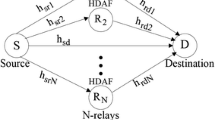Abstract
In this paper, we use self-adaptive dynamic differential evolution (SADDE) to search for multi-input/multi-output (MIMO) relay locations and transmitter locations to reduce the outage probability in the indoor ultra-wideband (UWB) environment. Amplify-and-forward (AF) MIMO relay is chosen to improve the performance of the environment. We use the shooting and bouncing ray/image (SBR/image) method to compute the frequency response, which is used to compute capacity. The channel capacities for the linear antenna with 1 × 1 antenna, 3 3 spaced linear antennas, and 3 × 3 tri-polarized antennas are compared. First, we deploy the relay and transmitter at the equipartition area. It is found that there are some outage receiving points. Thus, the SADDE is employed to optimize the position of the relay and transmitter in order to reduce the outage probability. Numerical results show that the outage probability for the relay and transmitter location is reduced by SADDE. Moreover, it is found that the channel capacity for the tri-polarized antennas has increased when comparing to 3 × 3 spaced linear antennas. For the zero outage probability requirement, the signal to noise for the tri-polarized antennas is lower 6 dB than that for 3 × 3 spaced linear antennas.






Similar content being viewed by others
References
Federal Communications Commission (2002) Revision of part 15 of the commission’s rules regarding ultra-wideband transmission system, first report and order, FCC, ET Docket, pp 1–118
Sharma S, Bhatia V, Gupta A (2016) Sparsity based UWB receiver design in additive impulse noise channels, in Proc. IEEE Signal Processing Advances in Wireless Communications, Edinburgh, UK, pp 1–5
Abdallah AB, Zribi A, Dziri A, Tlili F, Terr’e M (2017) Ultra wide band audio visual PHY IEEE 802.15.3c for SPIHT-compressed image transmission, in Proc. IEEE Signal, Image, Video and Communications, Tunis, Tunisia, pp 59–64
Jianfeng L, Defu J, Xiaofei Z (2017) DOA estimation based on combined unitary ESPRIT for coprime MIMO radar. IEEE Commun Lett 21(1):96–99
Said MM, Yahia MMA (2015) On cross correlation in antenna arrays with applications to spatial diversity and MIMO systems. IEEE Trans Antennas Propag 63(4):1798–1810
Sebastien C, Said MM, Yahia MMA (2015) A generalized methodology for obtaining antenna array surface current distributions with optimum cross-correlation performance for MIMO and spatial diversity applications. IEEE Antennas and Wireless Propagation Letters 14:1451–1454
Wojciech JK (2016) Space diversity parameters of MIMO systems small antenna array for mobile terminal, in Proc. European Conference on Antennas and Propagation, Davos, Switzerland, pp 1–4
Foschini GJ, Gans MJ (1998) On limits of wireless communications in a fading environment when using multiple antennas. Wirel Pers Commun 6(3):311–335
Recioui A, Bentarzi H (2012) Genetic algorithm based MIMO capacity enhancement in spatially correlated channels including mutual coupling. Wirel Pers Commun 63(3):689–701
Recioui A, Bentarzi H (2013) Capacity optimization of MIMO wireless communication systems using a hybrid genetic-Taguchi algorithm. Wirel Pers Commun 71(2):1003–1019
Recioui A, Bentarzi H (2016) Application of a galaxy-based search algorithm to MIMO system capacity optimization. Arab J Sci Eng 41(9):3407–3414
Liu Q, Zhang W, Ma X, Zhou GT (2012) Designing peak power constrained amplify-and-forward relay networks with cooperative diversity. IEEE Trans Wirel Commun 11(5):1733–1743
Ngo HQ, Quek TQS, Shin H (2010) Amplify-and-forward two-way relay networks: error exponents and resource allocation. IEEE Trans Commun 58(9):2653–2666
Yang K, Yang J, Jinsong W, Xing C, Zhou Y (2012) Performance analysis of DF cooperative diversity system with OSTBC over spatially correlated Nakagami-m fading channels. IEEE Commun Lett 16(3):1270–1281
Haghighat J, Hamouda W (2012) Decode-compress-and-forward with selective cooperation for relay networks. IEEE Commun Lett 16:378–381
Tang X, Hua Y (2007) Optimal design of non-regenerative MIMO wireless relays. IEEE Trans Wirel Commun 9(4):1398–1407
Cheng YT, Chiu CC (2015) Optimization of the antenna location for relay cooperative system by APSO. Wirel Pers Commun 83:2485–2495
Sun CH, Chiu CC (2013) Inverse scattering of dielectric cylindrical target using dynamic differential evolution and self-adaptive dynamic differential revolution. International Journal of RF and Microwave Computer-Aided Engineering 23(5):579–585
Chiu CC, Sun CH, Li CL, Huang CH (2013) Comparative study of some population-based optimization algorithms on inverse scattering of a two-dimensional perfectly conducting cylinder in slab medium. IEEE Trans Geosci Remote Sens 51:2302–2315
Storn R, Price K (1995) Differential evolution - a simple and efficient adaptive scheme for global optimization over continuous spaces, Technical Report TR-95-012. International Computer Science Institute, Berkeley
Author information
Authors and Affiliations
Corresponding author
Additional information
Publisher’s note
Springer Nature remains neutral with regard to jurisdictional claims in published maps and institutional affiliations.
Rights and permissions
About this article
Cite this article
Chiu, CC., Cheng, YT. & Yang, CH. Capacity optimization of multi-input/multi-output relay channel by SADDE algorithm. Ann. Telecommun. 74, 365–372 (2019). https://doi.org/10.1007/s12243-019-00708-8
Received:
Accepted:
Published:
Issue Date:
DOI: https://doi.org/10.1007/s12243-019-00708-8




